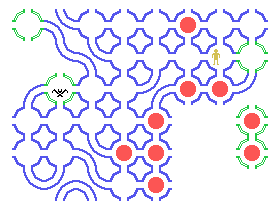R
Retro_Dude
Guest
Hello everyone, I'm having a small bit of error I could use some tips on.
I'm doing a clone of Hunt the Wumpus for the TI-99 and the only thing left is doing the tunnels. I kind of got it working but once in a while there are parts that block off the tunnels.
My way of handling the generation is: On created, the pieces are placed randomly on the map, and I do a check to see if a compatible part is next to another compatible part, if not they shuffle around randomly until a layout is generated.
I guess I'm looking for hints on a failsafe mechanism so the generation doesn't stop until it's perfect.
Example:

I'm doing a clone of Hunt the Wumpus for the TI-99 and the only thing left is doing the tunnels. I kind of got it working but once in a while there are parts that block off the tunnels.
My way of handling the generation is: On created, the pieces are placed randomly on the map, and I do a check to see if a compatible part is next to another compatible part, if not they shuffle around randomly until a layout is generated.
I guess I'm looking for hints on a failsafe mechanism so the generation doesn't stop until it's perfect.
Example:


